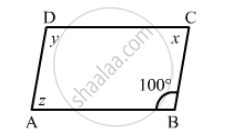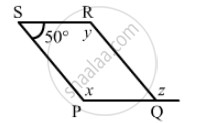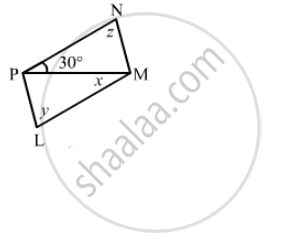Advertisements
Advertisements
प्रश्न
Diagonals of a rhombus are 20 cm and 21 cm respectively, then find the side of rhombus and its perimeter.
उत्तर

Let `square`ABCD be the rhombus.
AC = 20 cm, BD = 21 cm
AO = `1/2` AC ...[Diagonals of a rhombus bisect each other]
= `1/2 xx 20`
= 10 cm ...(i)
BO = `1/2` BD ...[Diagonals of a rhombus bisect each other]
= `1/2 xx21`
= `21/2`
= 10.5 cm ...(ii)
In ∆AOB,
∠AOB = 90° ...[Diagonals of a rhombus are perpendicular to each other]
By Pythagoras theorem,
∴ AB2 = AO2 + BO2
∴ AB2 = 102 + 10.52
∴ AB2 = 100 + 110.25
∴ AB2 = 210.25
∴ AB = `sqrt(210.25)`
∴ AB = 14.5 cm
Perimeter of `square`ABCD = 4 × AB
= 4 × 14.5
= 58 cm
APPEARS IN
संबंधित प्रश्न
The following figure is parallelogram. Find the degree values of the unknowns x, y, z.

The following figure is parallelogram. Find the degree values of the unknown x, y, z.

The following figure is parallelogram. Find the degree values of the unknown x, y, z.

Which of the following statement is true for a rhombus?
Its diagonals bisect each other at right angles.
Which of the following statement is true for a rhombus?
Its diagonals are equal and perpendicular.
ABCD is a rhombus. If ∠ACB = 40°, find ∠ADB.
One side of a rhombus is of length 4 cm and the length of an altitude is 3.2 cm. Draw the rhombus.
If all sides of a quadrilateral are equal, it is a ______.
All rhombuses are squares.
ABCD is a rhombus such that the perpendicular bisector of AB passes through D. Find the angles of the rhombus.
Hint: Join BD. Then ∆ABD is equilateral.
